Aries Cerat Heléne DAC and Incito S preamp
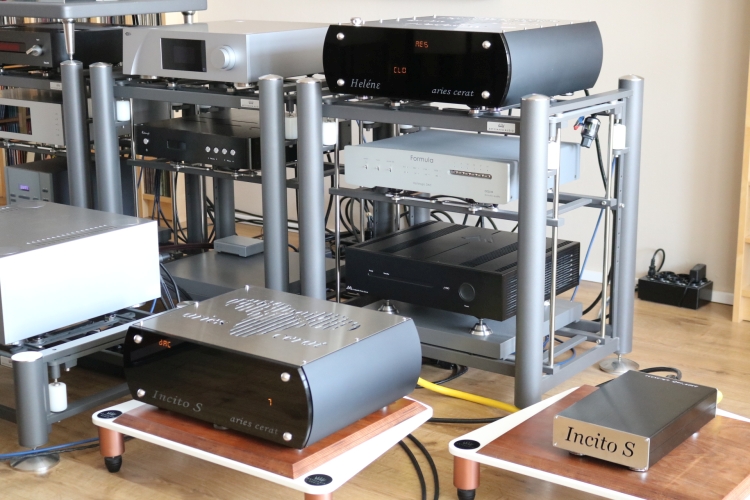
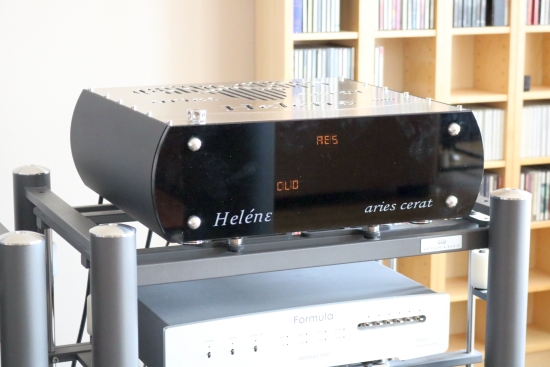
Aqua Formula xHD with AES/EBU
Substituting Heléne DAC for Aqua Formula xHD DAC while retaining the Incito S makes for an interesting comparison. As I mentioned when using the AES/EBU connection, even when using the relatively relaxed-sounding Driade XLR cables for the CH DAC and the Stealth Indra RCA cable for the Incito S, the direct DAC to power amp connection remained the most articulate and direct-sounding solution. However, the gap is all but closed when using the Aqua DAC with the Incito S. The Formula xHD has always been one of the most detailed, most linear, and most transparent DACs that I have heard and, fair is fair, while the Heléne DAC does not surpass the Formula xHD in these areas, it does very nearly equal it in terms of resolution and it’s definitely a tie in terms of finesse and refinement.
The biggest difference between these two DACs is, you guessed it, in the bass. Indeed, the Aqua DAC sounds considerably tighter and more controlled than the Heléne DAC which, as is now definitely confirmed when used with AES/EBU, sounds quite lush and relaxed. Its bass is of the deep and voluptuous yet unforced, slightly relaxed kind and this takes some getting used to again after having been accustomed to the Aqua. Vice versa, the Aqua’s bass can appear as being a little too controlled when you’ve been listening to the Heléne DAC for some time. Of course, we’re talking transistor versus tube output stages and these differences, while larger than anticipated, are not out of the ordinary.
What this illustrates very neatly is just how transparent the Incito S preamp is! Any warmth that I noted so far, is likely coming from the DAC.
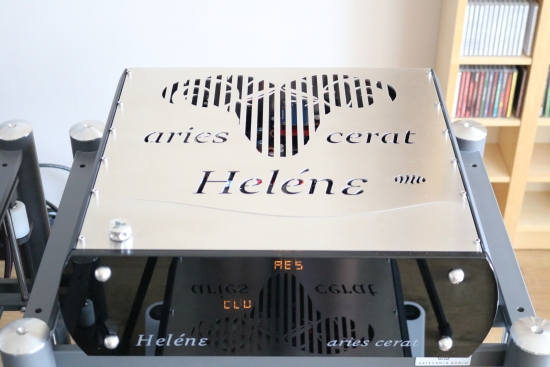
I certainly like the Aqua’s super-tight bass but it takes little time to hear that the DAC’s superb control also affects the soundstaging which is quite stilted compared to the Heléne’s. And whereas the C1 DAC sounded just as voluminous in terms of soundstage size as the Aries Cerat combo, the Aqua DAC’s firm grip subjectively reduces the distance that the soundstage projects both in front and behind the speakers.
Given an AES/EBU source, the two DACs really are very different in their presentations. Exaggerating a little, the Heléne’s natural flow makes the Aqua seem strict and somewhat restrained but the Aqua’s tight and articulate bass, in turn, makes the Heléne’s transient behavior seem rounded.
When replacing the Mogami with the Jorma AES/EBU cable, the sound is significantly improved across the board with better focus and higher realism, but still, it doesn’t achieve the same tightness, transparency, and ultimate resolution of the USB connection. And that’s with the no-name cable still in place! When replacing the no-name USB cable with the Vermouth Reference or the Final Touch Audio Callisto, the sound is further enhanced, respectively by becoming fuller and more deeply saturated and by becoming airier and more fluid.
Aqua Formula xHD with USB
Switching to USB, the DACs most definitely crawl closer to one another. As observed earlier, the Heléne DAC is absolutely transformed in terms of tightness, control, and overall transient behavior, and although I can imagine either presentation finding favor depending on personal preference, I personally definitely prefer its sound with USB over the other inputs. Comparing the two DACs via USB, I’d say that they are technically equally capable, if still different in presentation. The Aqua remains nimblest and most articulate while the Heléne remains the most free-flowing, naturally breathing, and organic.
All these experiments perfectly illustrate the relative quality of audio assessments. As mentioned, for the past year, I have consistently found AES/EBU to perform more consistently and to sound more convincing than USB, and the latter always having a certain technical quality to it, with the Heléne DAC, this quality clearly works in the DAC’s favor, perfectly balancing out the DAC’s inherent smoothness with the interface’s precision.
With the Heléne’s USB input performing so much more impressively than the AES input, there was one comparison that I just had to make with this DAC, which is the Antipodes K50 versus Grimm MU1 music server, with which I started my listening.
Well, I had already figuratively been slapped in the face when swapping to the Heléne’s USB interface but now, let me be unashamedly Dutch by exclaiming that my trousers dropped and my wooden shoe broke. Indeed, my jaw dropped to the floor, for now, the Antipodes K50 sounded tighter and more direct than the MU1. Believe it or not but despite the K50 having consistently sounded sweeter and more relaxed than any other server, most definitely the MU1, now, the latter got a taste of its own medicine. Even when focusing on the resolution, one of the Grimm’s strengths, I could no longer say that the K50 was in any way behind. But of course, this is when comparing USB on the K50 to AES/EBU on the MU1. Since the latter does not offer USB, this is as far as I can take this comparison. Boy, you just got to love the mysterious world of digital audio.
With all this focus on the Heléne DAC, one would almost forget that the Incito S has quietly been in use all this time. As long as I was using AES/EBU (or coaxial, for that matter), I got the feeling that the Heléne DAC makes the biggest contribution with respect to the harmonic richness and organic flow, while the preamp was performing more or less anonymously. This feeling was further substantiated when switching from AES/EBU to USB. Now, it was time to put this to the test.
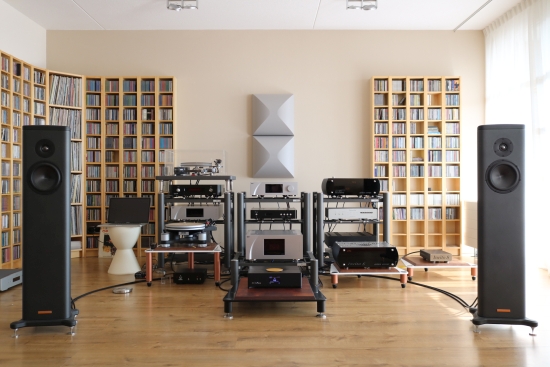
Using Incito S preamp with CH C1 DAC
I invited my close friend JW for this last comparison. Having a complete Zesto system, he is a dedicated tube lover who can’t stand many transistor products. He kindly makes an exception for CH as he notes that it sounds neither tube-like nor typically transistor-like. Of course, CH equipment does not mimic a tube sound and it’s not intended to do so. But the A1.5 amplifier, in particular, does manage to not have any of the traditional transistor downsides. The more I combine it with other products, the more I find that it is very much a chameleon.
Let’s see how the Incito S preamp behaves in conjunction with the CH C1 DAC. For this purpose, I will set the C1’s volume to unity so that it behaves like a regular DAC. I will then listen to the C1+A1.5 combo as I normally do and then add the Incito S in between. When using the C1 DAC directly, I used only the Driade Flow Link Reference 808 RCA cable, and when also using the Incito S, I used the Driade Flow Link Reference 808 RCA cable between DAC and preamp, and the Stealth Indra RCA between preamp and power amp. Now, we will find out how much, or how little, it adds.
“WOW”, is what I proclaimed, as the first notes flowed through from the C1 via the Incito S to the A1.5. Granted, the direct DAC to power amp remains tighter and more direct but the Incito S did not shave off even the tiniest amount of energy or impact, and the delivery was every bit as impactful and dynamic while adding just the right amount of fluidity.
Even though I found the C1 DAC to be remarkably fluid and refined when comparing to a direct Wadia to power amp connection (which results in a particularly robust but also considerably dry sound), the Incito S neatly illustrates that the C1 when used with its volume control and no preamp still leaves out a measure of ultimate refinement and fluidity.
Additionally, the flow, soundstage depth and imaging within, and the music’s lyrical quality all improved quite significantly. Yup, there is no way around it, if one seeks the ultimate in tightness and control then using a DAC direct to a power amp is an almost unbeatable solution but if the music’s breath and the organic flow are paramount, then there seems to be no way around adding a great tube preamp.
Although this exercise was a little sobering for me when returning to the C1 on its own, it was still very satisfying to realize just how chameleon-like the A1.5 poweramp behaved when it was partnered with the Aries Cerat Incito S preamp. JW also commented that with the Incito S in the signal path, it was as though I had also swapped the power amp for a tube product. Honestly, if we’d do a blind test, I doubt that even the most seasoned tube fanatic will have anything negative to say about the combined sound.
Still, let’s not forget that the one product that made this possible was the Incito S. Given that it has a transformer volume control, and understanding the principle behind it, I was more or less prepared to be treated to a powerful sound but it was still a big surprise to find how little the Incito S added in terms of tonality or character. In spite of all the abovementioned extra qualities that it managed to extract from my system, it is essentially transparent. It can’t easily be described for what it does, so here’s what it does not do. It doesn’t add warmth or body nor does it subtract richness or saturation, it doesn’t emphasize any part of the audio band and its frequency range seems flat top to bottom, it doesn’t mask any detail nor does it round off transients, resolution, or the overall dynamic impact, and yet it also does not add any hardness or edge. What this preamp achieves has truly amazed me. I’ve not nearly heard all the range-topping preamplifiers that are available but I’ve heard quite a few and I can say with confidence that the Incito S ranks all the way at the top, even surpassing the considerably more expensive CH L1 in several important aspects. As one might expect, the L1 manages tighter bass and an even more direct presentation but it has to yield to the Aries Cerat in the aspects of flow, breath, tonal saturation, and overall richness, and perhaps most importantly; Sheer musical engagement.

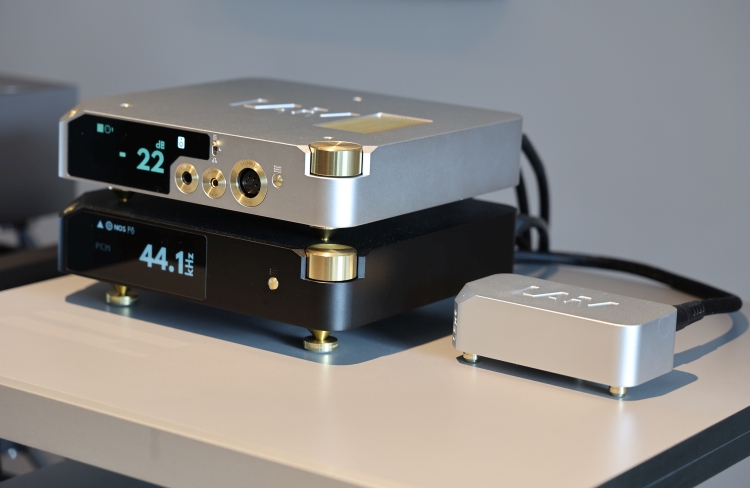





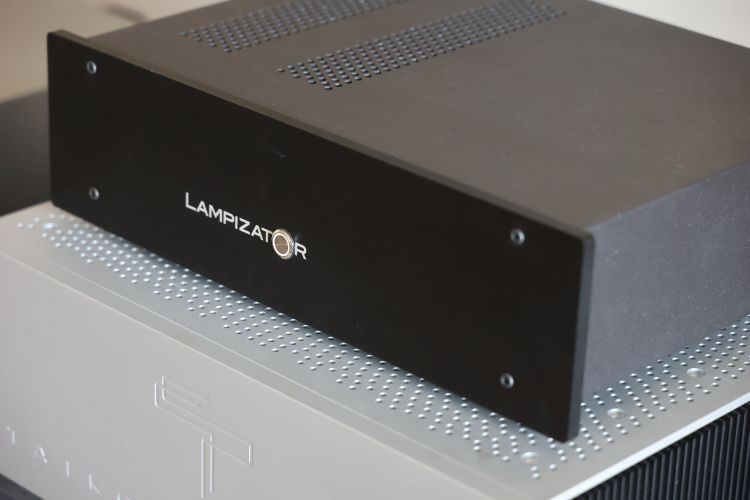
Christian,
Great review on a brand I’ve heard a little about but never seen a review of. And you’ve certainly proven what are some truisms for me, a preamp is crucial to ultimate sound quality, and all things being equal tubes are best. 😉 Now all things are rarely equal of course but that Incito preamp sounds pretty special I’ve always found a tubed preamp to have an outsized effect on overall sound quality. I doubt I’ll ever hear one but would love to.
Cheers,
Jon
Thanks, Jon, the Incito S truly is something else. And Ron tells me that the bigger preamp “walks all over it”… Gulp. I thought hard about which award to give it but even if I will have no higher praise than “Magnificent Masterpiece” to award, should I ever review the Impera preamp, I decided to award it to the Incito S.
Jon,
I discovered Christiaan’s website quite by chance recently. Since then, I stay tuned.
I am the very happy owner of an Aries Cerat *Incito* preamp (not the S version, so mine has an embedded power supply; the S version has a separate PS).
It easily replaced my YBA 1 preamp (which had a separate PS).
The Incito changed my system. That thing is not of this world. Period. Some say that Aries Cerat preamps are the only ones which decide the aficionados of passive preamps to abandon their fetish.
I attend to live concert regularly, so I do not like “typical” tubes devices (honey-topping on everything). This one is truly different. I was amazed by the amount of both body&liveliness, distinction&exuberance, flesh&transparency it could deliver. A dizzying ability to deliver qualities that other high-end devices have accustomed us to consider as opposites. Here, they are reconciled/synthesized with a stunning mastery.
Try to listen to one.
FYI, my *power amplifier* is a YBA Signature Classic stereo (100w), very “liquid”-sounding.
(I also listened to a whole Aries Cerat system, in a very good room: gobsmacking…)
Orfeo that’s very cool and quite a good system you have YBA is another brand somewhat underrepresented here in the US that I’ve never heard. The Incito sounds like an amazing piece of gear, I hope Aries Cerat will show their gear at US audio shows, whenever they start happening again. The Capitol Audiofest here in DC is my outlet for hearing gear I otherwise might now, And Orfeo may I ask what speakers you’re pushing with that lovely amplification stack?
Cheers,
Jon
P.S. Agreed Christian is one of the very best and most thorough reviewers out there.
Please allow me to report additional experiences with the Synergistic Orange fuses and Aries Cerat. The review mimics my own experience, and if it all stayed just like that it would be a very nice tweak to put it mildly. But after some week of daily playing, there is no less than a small transformation here.. the bold euphoric ‘technicolor’ impression at first date seem to shift into a more speedy, open and articulate sound. It sounds more balanced now, and all is like a wide open window onto the musical landscape. It may sound silly, but the Orange Fuses need playing… Both Genus, Incito and Heléne have the Orange in. Great stuff, highly recommended.
Thanks for the helpful feedback, Ron!
Wow THAT’s a review! Thank you very much Christiaan for the hard (pleasant) work such a thorough review must have required. Testing all combinations must have been very time-consuming.
Regarding the TUBES LIFECYCLE, I read in the review that
1. “the manual […] mentions avoiding frequent on-off switching of the unit to preserve tube life.”
2. “That’s why Ron simply always leaves them switched on and told me to do the same. I should note that in this case, the tubes will respectively last at most 250 and 375 days”
As a very happy owner of an Incito preamplifier since 2018, this grabbed my attention:
point 1: avoid “frequent” on-off switching. What do they call “frequent”? I always do max ONE on-off switch per day. I do not let the preamp burning all day when I am away. Moreover, I know that there are 5 chokes inside the Incito, so I suppose they damp the ‘brutality’ of on-off switches, don’t they? If so, what’s the point in keeping the device turned on? (except to avoid any warm-up time, which is a different issue).
However, regarding point 2, leaving the device ON permanently ensures the reviewer that the device plays at its full potential all the time indeed. Which is commendable, especially for a reviewer.
So, as far as I understand,
– if I leave the device ON all day, 24/7 => tube life=250/375 days (rectifiers/E280F, respectively)
– if I turn the device ON when I come back home, and OFF when I go to sleep => tube life=approx. 5 years, BUT a warm-up time has to be endured everyday. A warm-up of 30 min/1h is said to be sufficient, but not everyone agrees.
Am I correct? Or am I missing something?
Thanks.
Glad to hear you liked it, Orfeo! Indeed, this has been a lot of work, but when any question forms in my mind during a review, I NEED to investigate it and report on it. I can’t help myself…;-)
Regarding warm-up, in general, my experience is that 45 minutes gets you pretty much all the way there with most tube equipment, with small incremental improvements in the hours thereafter, for some equipment.
As for what constitutes frequent switching, that’s a great question but not one that I can answer. All I can say is that I personally prefer not to leave tube equipment on when I’m not listening to it. Typically, I have the Ayon gear switched on for around 5 hours per session but since they are in my secondary system, I only use it about once a week. The same applies to the Ayon Stealth that I use in combination with the turntables in the main system.
Perhaps Ron or Stavros are willing to get into more detail with regards to tube life versus power cycles.
Hello Orfeo
What is recommended, is turning the units on and off during your sessions, or maybe a few hours before. Though units can stay on 24/7 it is not really optimum for tube life.
What I would call frequent on-off, is the habit of very few people, turning on and off the units several times a day, listening for example for an hour, turning off, and then on again after a while.
Certainly 2-3 power cycles a day is far from calling it frequent on-off.
On turn on, though triple choke filtered, the rectifier is always having its roughest moment of the day 🙂
Cheers
Stavros
Tubes are a hotly debated topic. Of course, there are many different opinions, or different experiences. It is a choice to leave a tube DAC or Pre-amplifier always on or not. The suggested lifetime is just that; a suggestion, maybe a prediction. There are always extreme examples concerning tube lifetime, there are power amplifiers whose tubes after 25 years of continuous work still measure as new. Of course that is exemplary, and quite out of the ordinary. There are also known amplifiers that need new tubes about every year (..), and sometimes including the tube sockets. In principle it is a good idea to measure all tubes every (half) year, and to write down the values. Personally, I find it a bit too much to keep the Genus 813P in continuous operation, but the Incito and Heléne are fine for me. Only time will tell to what extent the GZ34 and E280F will decrease in measured values. It’s a balancing act, and for me personally, that choice is in favour of always leaving it on. As they say: Your Mileage May Vary. In the meantime; Keep spinning and enjoy the Music!
Are you using the preamp incito with the integrated amp genus. Is it advisable and does it make any improvement.
I have not tried this, so alas, cannot comment with any certainty. In general, I would not expect an integrated amp to very easily have a similar quality preamp on board as good as the Incito S. On the other hand, integrated preamps benefit of shorter signal paths and optimized circuitry. What I can also say is that pretty much any amplifier will allow you to hear the benefits of a better preamp. In fact, I’d rather have an expensive preamp and a less expensive power amp than the other way around. But ultimately, I cannot make any hard claims, only recommend to just try it.
I know from a VERY reliable source that
Incito preamp* + Genus P** does not quite equals a Genus integrated (because 1. shorter signal paths, as Christian said, and 2. identical volume control on both, i.e. relays).
*Incito preamp = ‘basic’ model, NON-S (=Prestige Series)
**Genus P = the POWER AMPLIFIER ONLY version of the Genus.
**BUT** if you consider the Incito S (=Reference Series) as a preamp, that becomes another story (the volume control here is better, with TVC system, that is based on a transformer; it is said to be the best volume control systems of all).
I have NO information regarding such a combination (Incito S + Genus P).
You don’t mention which gear you already own. But, as Christian said, yes, it is advisable to get the best possible preamp first, then see what you can later afford as a power amp, and which one does the best match with your speaker. This way, the preamp can become the tether of your system, the gear that will go along with you during all your audiophile life.
Happy listening.
Great reply, Orfeo!
Is de Dac Helene een meerwaarde voor mijn huidig systeem? Dit bestaat uit de Accuphase E600 en de B&W 803D3.
Is the Dac Helene an added value for my current system Accuphase E600 and B&W 803D3?
Hi Marc, I’m assuming you have the DAC board installed in the E600? In that case, the Helene will indeed have a lot to offer. What the converter board does very well is pacing, articulation, and dynamics. It’s not the best in terms of refinement, fluidity, and flow. And that’s exactly where the Helene does excel, among other things. Of course it depends on what you value most in the sound. In general, though, I’d say the Helene is considerably better. The only reservation against the Helene that I could think of is if you value bass tightness over all else. But that goes for a large majority of tube products.
Hi Christiaan. I want to know if Aries Cerat Dacs decode DSD. Although it´s rate samples is up to 24/384Khz, I couldn´t find if decode dsd or only PCM. Thanks
Hi Pablo, the Helene only converts PCM, no DSD.
Hi Christiaan, Just curious whether you’re still using the Orange fuses? Or have you moved back to previous uses or perhaps even “upward” in the SR line to say, their Master fuses. In any case, if you did switch, I’d be curious why.
These Aries Cerat products, as well as the fuses, were supplied for review. After publication, they all went back. I did not try any SR fuses in other equipment after that, mostly because I prefer tightness, control, and neutrality over smoothness, saturation, luxuriousness, or warmth. However, there are indeed other, more neutral SR fuses that I might try some day.
Thanks for the update on the fuses, Christiaan! So are using stock fuses now or the Hindi Tuning ones, perhaps?
I use stock fuses in all components. However, for the main system power supply, I do use a Siemens Sitor Cylindric Fuse Cartridge (with standard silver-plated fuse and solid silver rod), followed by GigaWatt G-044 Schuko Wall Sockets, and a PS Audio PowerPlant P20.
You can track all of my system components as well as the changes over time here: https://www.hifi-advice.com/blog/category/hfa-audio-setup-snapshots/
Thanks, Christiaan! Looking back on what you said, it’s interesting as the qualities you said you prefer are the ones that I seem to hear people attribute to SR fuses (over the ones you mentioned you don’t prefer):
“mostly because I prefer tightness, control, and neutrality over smoothness, saturation, luxuriousness, or warmth.”
So you noticed the SR fuses being smooth, saturated, luxurious and warm?
That is correct, I perceived the fuses I heard as part of this review as smooth, saturated, and luxurious They were less tight, crisp, and neutral than the standard fuse.